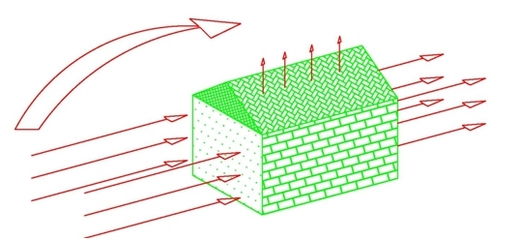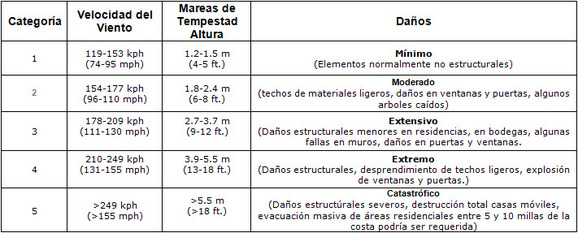Hurricanes and Their Effects on Buildings
Preserving the Building
The severe and complex nature of hurricane-force winds presents unique problems for protecting a building. Under normal circumstances, a building is designed to allow wind to flow over the structure. During a hurricane, a fully intact building allows wind to flow at, over, and past the structure without damage. Preserving the envelope (or ‘outer skin’) of the building is one the most important steps in preserving the integrity of the structure and ensuring non-destructive wind flow during hurricane-force winds.
FIGURE 2: PRESERVING THE BUILDING ENVELOPE:
During a hurricane, intense pressure is created on a structure. As the wind flows over or around a structure it can cause "lift" on the roof or "suction" on the opposite side (leeward face). This "suction" is normally referred to as negative pressure. Negative pressure is always higher than the positive pressure acting upon a building during hurricane conditions.

If the building envelope is breached, wind also enters the building, thereby causing a dramatic increase in internal pressure. This force can lift the roof and push the walls outward (see Figure 2). One of the most susceptible components of the building structure is an opening for a window or door. True hurricane protection is designed to accept the impact from wind-borne debris without evacuating the opening and causing a breach in the building envelope. It is the only way to protect the structure and its contents.
HURRICANES, TYPHOONS AND TROPICAL CYCLONES
Storms producing high winds encircle the globe. The term "tropical cyclone" is a generic name for a low pressure system that is non-frontal and occurs over tropical and sub-tropical waters. When the winds reach 119 kph (74 mph), the storm is considered a hurricane in the North Atlantic and eastern parts of the north and south Pacific Oceans (a typhoon in the northwest Pacific Ocean). Because of our regional media interest, we are most aware of hurricanes in the Atlantic and Gulf coasts of the United States, as well as the Caribbean. Hurricanes are capable of producing sustained winds of 193 kph (120 mph) or more.
When a hurricane passes a building, the winds become turbulent and change direction. During the often-long duration of a storm, loose objects and damaged buildings add to wind-borne debris, which can impact windows and doors. The Saffir-Simpson Hurricane Scale (see Figure 3) was developed to provide an estimate of potential damage during a hurricane due to flooding and destruction caused by the wind and wind-borne debris. The scale is based on ratings from one through five with five being the most severe. Wind speed is the determining factor for the Saffir-Simpson rating as it affects the amount of flooding and potential damage.
Table 3: Summary Chart of Saffir-Simpson Hurricane Scale
Wind and Debris
As a hurricane passes, winds change direction, altering the direction of pressure being exerted on the building. During the sustained and high-speed winds of a hurricane, debris can be lifted from its at-rest position and become an airborne missile or wind-borne debris.
Preservation of openings and therefore the integrity of the building envelope is made difficult by the presence of wind-borne debris. In a hurricane, wind-borne debris can become a damaging missile. Large missiles, such as roof shingles and other construction materials, are common at heights up to 9 m (30 ft.) above grade; smaller missiles, such as roof gravel, are most prevalent at heights above 9 m (30 ft.). Following the impact from one of these missiles, building materials need to maintain the building envelope as they continue to be subjected to sustained and gusting winds until the hurricane passes.
Requirements for Protection
Hurricanes will occur; wind-borne debris will be present; and the result is an uncontrollable natural event. To protect a building during a hurricane, the building envelope must be maintained. To prevent the building envelope from being compromised, windows and doors, typically the weakest link in a building’s envelope, must be safeguarded from penetration by wind-borne debris, and they must also remain in place throughout the remainder of the storm.
Hurricane Fabric’s AstroGuard system is designed to handle the damaging impact from wind-borne debris and remain in the opening during cyclical wind loading. In the past, temporary or permanently attached shutters were used to protect residential and commercial buildings in hurricane-prone areas.
Hurricane Fabric’s AstroGuard, in properly designed windows and doors, eliminates the need for shuttered systems because the fabric is ballistic and can withstand wind loads and projectiles in excess of 1,500 psi, where a hurricane category 5 can only produce 1,200 psi of force or strength. That is to say should the glass or even the door behind the AstroGuard hurricane fabric fail or break, the AstroGuard system will continue to stop the wind load or force to maintain the building envelope and as a result, it will protect the integrity of the building itself.

